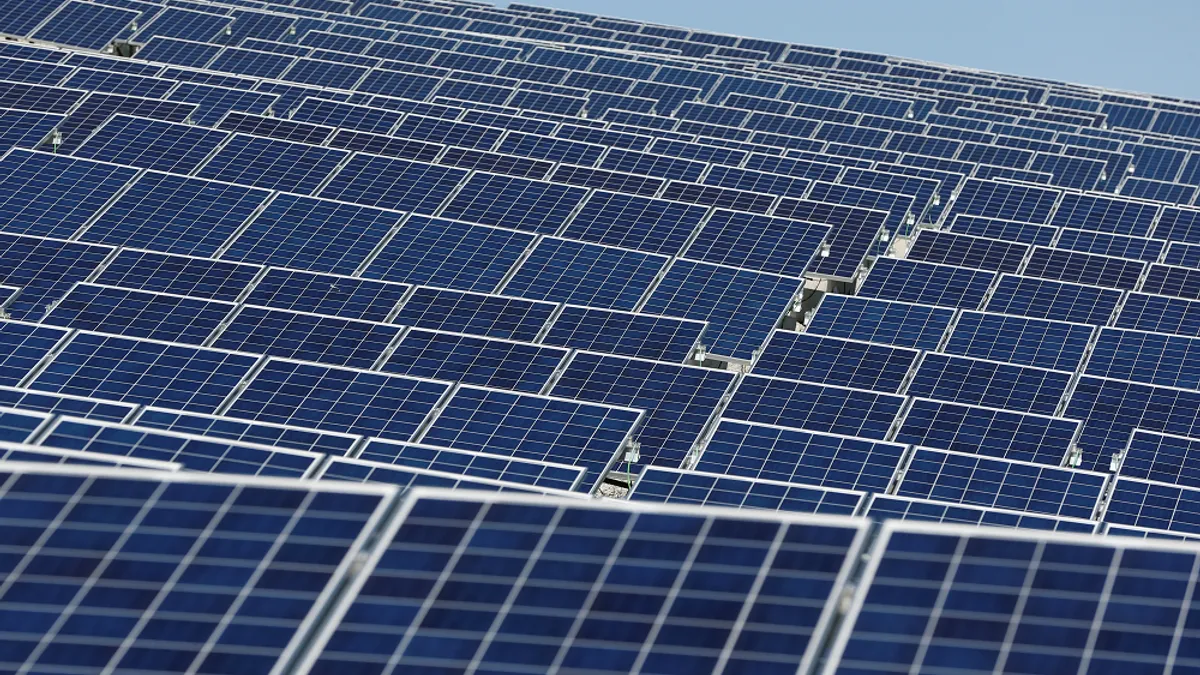Dive Brief:
- South Carolina regulators on Thursday rejected Duke Energy's integrated resource plan (IRP), which contained several different proposals for meeting long-term demand including development of new gas-fired plants.
- The Public Service Commission (PSC) is asking the utility to make several changes to its plan related to natural gas cost projections and how it models the competitiveness of renewables and storage. And its assessments must include 20-year Purchase Power Agreements for solar priced at $38/MWh.
- Solar energy advocates praised the decision, saying it could require Duke to rethink potentially costly gas-fired plants and add more solar capacity. Duke defended its plans, arguing they are "prudent" to "meet customer needs long-term."
Dive Insight:
South Carolina's PSC vote 4-1 to reject the IRPs proposed by two Duke subsidiaries, Duke Energy Carolinas and Duke Energy Progress.
The motion passed by the commission states that the companies "did NOT prove by the preponderance of the evidence that their 2020 IRPs are the MOST reasonable and prudent means of meeting their energy and capacity needs."
The commission's directive calls into question both the modeling Duke used to project future natural gas prices and its estimation of the capacity of solar power to meet South Carolina's energy needs. And it calls on Duke and its subsidiaries to make several changes to the IRPs, including to modeling and energy price forecasts.
In addition, the commission also called upon Duke, which had presented six different potential plans or scenarios, to pick one "preferred alternative."
The decision was praised by R. Taylor Speer, an attorney representing Vote Solar, a nonprofit solar power advocacy group. As one of the intervenors in the regulatory IRP proceedings, Vote Solar has been critical of key aspects of the Duke IRPs.
Speer called the commission's directive a "significant win."
"The directive is a strong indication the commission was concerned that the Duke companies did not accurately account for the benefits that solar, storage, demand-side management, and energy efficiency provide to the utilities' system," Speer said.
Maggie Shober, director of utility reform at the Southern Alliance for Clean Energy, or SACE, offered a similar assessment, saying she was "pleasantly surprised" by the South Carolina commission's directive.
"We agree that those were areas of the IRPs that needed much improvement," said Shober, noting SACE was part of coalition of groups that intervened in the process and submitted testimony.
The commission's directive detailed 20 different modifications it wants to see Duke make when the utility and its subsidiaries refile their IRPs.
The commission wants Duke to "remodel its portfolios using natural gas pricing forecasts that rely on market prices for eighteen months before transitioning over eighteen months to the average of at least two fundamentals-based forecasts," according to the directive.
The modeling the commission is asking for, in turn, could offer a more realistic, or higher projected price for natural gas, giving a boost to the competitiveness of solar, Speer noted.
The commission's directive also calls for a number of changes in how Duke assesses the pricing and competitiveness of solar energy.
The utility needs to include in its assessments "third-party solar Purchase Power Agreements (PPAs) priced at $38/MWh as a selectable resource," with contracts of at least 20 years.
In addition, Duke needs to "adjust its IRP modeling to account for the effect of the December 2020 Investment Tax Credit extension by Congress for solar development," the commission states
Duke is now awaiting a formal order from the South Carolina regulatory body, which typically provides a greater level of detail, said Ryan Mosier, a company spokesperson, in an email.
The "integrated resource plans we filed are prudent plans to meet customer needs long-term," Mosier said.
The six "portfolios" Duke presented to the PSC "keeps us on a trajectory" to meet the company's "near-term carbon reduction goal of at least 50% by 2030 and long-term goal of net-zero carbon output by 2050 in the Carolinas," according to Mosier.
In addition, the IRPs filed by the Duke subsidiaries also allow for "exploring faster coal retirement and the addition of more solar and storage," the company spokesperson said.
"We are in the midst of an unprecedented, long-term transition from a fleet that included coal generation towards a new mix of cleaner generation, including renewables, battery storage systems, carbon-free nuclear and efficient natural gas across the system," Mosier said. "In light of this transition, the 2020 integrated resource plans support a diverse energy mix."














